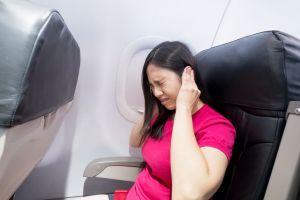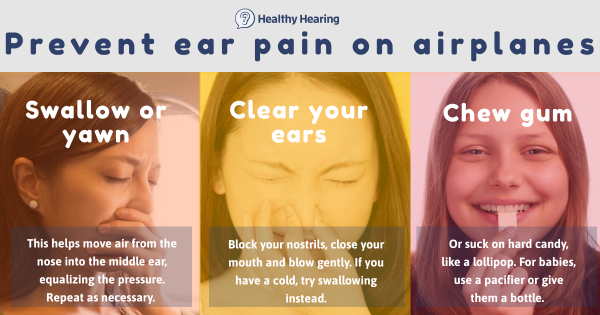Regardless of how much you paid for your seat, how much leg room you have or whether you are flying first class or coach, one thing many air travelers have in common is ear discomfort. Ear pressure, popping and even severe pain do not discriminate.
While most ear discomfort during air travel is nothing more than an annoyance, what happens when it becomes more serious? Unfortunately, the ear pain and pressure does, in rare cases, lead to severe pain and hearing loss, so it is best to take precautions, before, during and after your flight.
Increased pressure on ears

not prepared.
It all comes down to fluctuation in air pressure. Normally the air pressure inside the inner ear and the air pressure outside are essentially the same, or at least not different enough to cause any trouble. Even if you were to hike to the top of a tall mountain, the slow speed of your ascent would allow time for the pressure to equalize along the way. A problem only occurs when the change in altitude is so rapid, like it is in air travel, that the pressure inside the inner ear and the air pressure outside don’t have time to equalize. This is known medically as ear barotrauma.
When your flight takes off and the plane begins its ascent, the air pressure inside the inner ear quickly surpasses that of the pressure outside. The tympanic membrane or eardrum swells outward. Picture a loaf of bread rising while baking, and you get the idea.
Conversely, if air pressure inside the inner ear rapidly becomes less than the air pressure outside, the tympanic membrane will be sucked inward, almost like a vacuum effect. What has happened is that the Eustachian tube has flattened and needs a bit of help from you to continue to do its job of bringing air into the inner ear. Whether ascending or descending, the stretching of the eardrum can cause pain.
Whether ascending or descending, the stretching of the eardrum can cause pain.
During this time, the eardrum is not able to vibrate, so you also experience decreased hearing and muffled sounds.
How to prevent ear pain when flying

Everyone who has flown in an airplane has felt the effects of a change in altitude on ears; a feeling of fullness and popping is commonplace. You need to equalize the pressure by introducing as much air as possible via the Eustachian tube and there are several ways to do that.
- Swallowing – When you swallow, that clicking or popping sound you may hear is a tiny bubble of air that has moved from the back of the nose into the middle ear, via the Eustachian tube. The Eustachian tube ensures that the air in the middle ear is constantly being replenished. That air is then absorbed into the membranes of the inner ear, and the cycle starts over again. This constant cycle of air ensures that the air pressure on both sides stays equal. When you fly, the trick is to ensure that the Eustachian tubes work overtime and open more frequently to accommodate the change in air pressure.
- Chewing gum or sucking on hard candy – Chewing gum or sucking on hard candy will stimulate frequent swallowing which helps equalize air pressure.
- Valsalva maneuver – With a mouthful of air, close your mouth and pinch your nostrils shut. Gently force air out until ears your ears pop. This opens the Eustacian tubes. If you are sick with a cold or allergies, the Valsalva maneuver is not recommended, as it could cause a severe ear infection. Instead, try a lesser known method called the Toynbee maneuver: Close your mouth and nose and swallow several times until pressure equalizes. Repeat either technique as needed.
Other expert tips:
- Know the many causes of clogged ears, which can include anxiety
- If you can stay awake during ascent and descent.
- Drink lots of fluids in-flight to stay hydrated.
- Yawn.
- Try EarPlanes, specially designed ear plugs that have a filter to equalize pressure.
- Use nasal spray 1 hour prior to landing and only as-needed. Overuse of nasal sprays can cause more congestion.
- Take a decongestant 1 hour before landing and also post-flight until ears normalize.
Airplanes and ear pain in babies, toddlers and kids
For infants—whose Eustachian tubes are much narrower than an adult’s—the change in air pressure can be even more excruciating, so a bottle or pacifier is recommended to increase swallowing, especially upon descent.
Older children can suck on a lollipop, drink through a straw or blow bubbles through a straw to relieve ear pain. Before the flight, you can also talk to a pediatrician about the possibility of pain relieving eardrops for use in flight.
Don’t risk a ruptured eardrum
If you are very sick with a cold, the flu, allergies or congestion, you could consider changing your travel plans if possible. Your fellow travelers will appreciate one less sick person spreading germs around the plane’s cabin, and your illness can cause a blockage in the Eustachian tube, preventing the necessary equalization of pressure. A ruptured eardrum or severe infection can occur which can cause hearing loss or permanent ear damage.
See a hearing healthcare professional if your hearing doesn’t return to normal within several days post-flight. If you don’t have a regular hearing healthcare professional, check out our directory to find hearing clinics near you.
More: Wear hearing aids? Check out our air travel tips for people with hearing loss.
